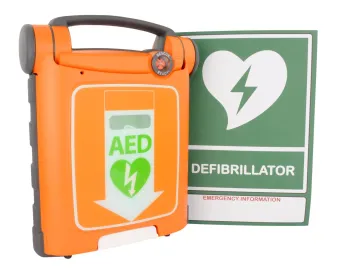Effective January 1, 2020, California Senate Bill 1397 will require certain buildings constructed prior to January 1, 2017, must have a defibrillator under certain circumstances.
California building owners and operators should take note of the new requirements affecting office, industrial, and retail buildings, as well as certain residential buildings such as hotels and motels. Apartment buildings and condominiums, however, are excluded from these requirements.
Landlords should carefully review their leases to determine how the responsibility for compliance with new laws is allocated in connection with any improvements to the property. Depending on the provisions in the tenant's lease, the tenant may be responsible for any costs associated with the defibrillator requirement.
OCCUPIED BUILDINGS REQUIRING A DEFIBRILLATOR
The new requirements apply to all of the following occupied buildings (Covered Buildings):
-
Buildings with an occupancy of 200 or more that are used for business (e.g., professional offices, banks, laboratories, etc.), educational, factory, institutional (e.g., hospitals, nursing homes, prisons, etc.), and retail purposes.
-
Residential buildings with an occupancy of 200 or more, such as hotels and motels, but excluding single-family and multi-family dwelling units such as apartments and condominiums.
-
Assembly buildings with an occupancy of more than 300 (e.g., restaurants, theaters, concert halls, indoor athletic facilities, libraries, museums, places of religious worship, arenas, etc.).
The defibrillator requirements do not apply to government buildings, licensed hospitals and nursing facilities, or vacant buildings.
Under the new law, Covered Buildings which were constructed prior to January 1, 2017, are required to have a defibrillator on the premises if one of the following occurs:
-
The building undergoes tenant improvements costing $100,000 or more in a calendar year.
-
The building undergoes renovations costing $100,000 or more in a calendar year.
-
The building is used as a place of assembly and is subject to any tenant improvement.
DEFIBRILLATOR REQUIREMENTS
Any person or entity that places a defibrillator in a building is required to comply with the provisions of California Health and Safety Code §1797.196, which includes maintenance and testing of the defibrillator, and periodic training for its use.
POTENTIAL IMPLICATIONS OF NONCOMPLIANCE
Although the statute does not specify what penalties, if any, would be assessed upon noncompliance with the provisions of these new requirements, a property owner's failure to comply with the statute would expose the owner to significant liability in the event a defibrillator could have been used in an emergency situation but was not located in the building.
In addition, it is likely that local municipalities would condition building permit approvals upon the applicant's compliance with this statute, and establish other local regulations deemed necessary to promote compliance.




 />i
/>i

